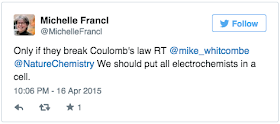Answer #1
Carbon (Chocolate)
Hydrogen (CHocolate)
Oxygen (ChOcolate)
Holmium (CHocolate)
Cobalt (ChoColate)
Lanthanum (ChocoLate)
Astatine (Chocol(ChocolAte)
Tellurium (ChocolaTe)
So you could have: CHoCoLaTe or CHOCOLate or....
Answer #2
(Presuming the letters are not required to be used in order - and yes, I wrote a piece of code to give me this for any word)
All of the above and
aluminum (Al), chlorine (Cl), calcium (Ca), cerium (Ce), helium (He), actinium (Ac), Technetium (Tc), thorium (Th), thallium (Tl) and tantalum (Ta)
Answer #3
Elements that have been detected in chocolate (in this case dark chocolate, rough percent of my recommended dietary allowance in parentheses assuming I eat only a 100 gram bar).
Carbon, hydrogen, nitrogen, oxygen, potassium (why cocoa is detectably radioactive), calcium (about 5% of my RDA), iron (125%), magnesium (70%), phosphorous, potassium (almost a gram, 20%), sodium, zinc (40%), nickel, sulfur, silicon, cadmium, lead (yep, lead, mostly from dust contamination during transport), mercury, arsenic, uranium (trace amounts, but yes, more radioactivity), aluminum, copper (from pesticides, but on the plus side gives you your RDA for this element), and manganese
Nearly one fifth of the known elements have been detected in chocolate, which clearly should be the backbone of any periodic diet.
What other elements are you eating?
Just in case your chocolate doesn't have enough radioactivity for you:








